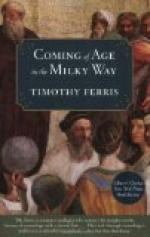
|
| Name: _________________________ | Period: ___________________ |
This test consists of 15 multiple choice questions and 5 short answer questions.
Multiple Choice Questions
1. What established a linear time-line in history?
(a) Islam.
(b) Asceticism.
(c) Christianity.
(d) Humanism.
2. There is suspicion that there may be undetected matter which astronomers refer to as what?
(a) Micrometer.
(b) Quantum flux.
(c) Parallax.
(d) Dark matter.
3. What is a device that uses electromagnetic fields to propel charged particles to high speeds and to contain them in well-defined beams?
(a) Lepton.
(b) Micrometer.
(c) Particle accelerator.
(d) Spectrometer.
4. William Herschel was the first astronomer to make "acute, systematic observations of the universe" beyond what?
(a) Jupiter.
(b) The moon.
(c) The solar system.
(d) The sun.
5. Quantum physics first emerged when who theorized that energy came in discrete units called quanta?
(a) Isaac Newtwon.
(b) Max Planck.
(c) Aristotle.
(d) Plato.
6. In Chapter 15, the author writes that physicists learned that when an electron was elevated into a higher orbit, it moved from lower to higher orbit without what?
(a) Traversing the intervening space.
(b) Gaining momentum.
(c) Gaining or losing heat.
(d) Gaining or losing energy.
7. Who published a paper in 1917 which provided evidence that the universe was expanding?
(a) Claudius Ptolemy.
(b) Jean Richer.
(c) Emanuel Kant.
(d) Vesto Slipher.
8. When was Albert Einstein born?
(a) 1798.
(b) 1879.
(c) 1818.
(d) 1919.
9. What Russian scientist theorized that the beginning of the universe may have started with a core so hot and dense that it created nuclear fusion and created the elements now known to man?
(a) George Gamow.
(b) Edwin Hubble.
(c) Fred Hoyle.
(d) Claudius Ptolemy.
10. What was the name of Charles Darwin's grandfather who had written the book, "Zoonomia"?
(a) James Darwin.
(b) Erasmus Darwin.
(c) Johann Darwin.
(d) Edwin Darwin.
11. Which astronomer discovered that some nebulae had spiral structures?
(a) Tycho Brahe.
(b) William Parsons.
(c) James Keeler.
(d) John Calvin.
12. Fermions fall into two categories: quarks which respond to force and what which do not react to force?
(a) Bosons.
(b) Nuclei.
(c) Leptons.
(d) Micrometers.
13. What are fuzzy patches of glowing material that can be observed throughout the universe?
(a) Leptons.
(b) Particles.
(c) Nebulae.
(d) Bosons.
14. In 1929, who confirmed movement away from earth and evidence of cosmic expansion?
(a) Claudius Ptolemy.
(b) Edwin Hubble.
(c) Fred Hoyle.
(d) Georges Lemaitre.
15. Where was Charles Darwin from?
(a) Spain.
(b) England.
(c) Germany.
(d) France.
Short Answer Questions
1. When was William Herschel born?
2. Who wrote, "The greatest of all the accomplishments of twentieth-century science has been the discovery of human ignorance"?
3. What is defined as a sacred narrative explaining how the world and humankind came to be in their present form?
4. Who concluded that the process of the earth's creation was part of an infinite repeating cycle of development and destruction?
5. Kant first became interested in space travel after reading a review of what philosopher's book?
|
This section contains 423 words (approx. 2 pages at 300 words per page) |

|




